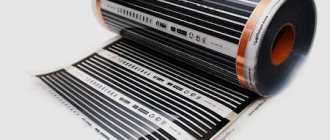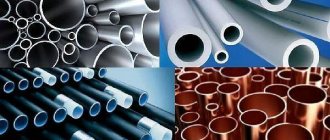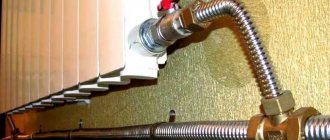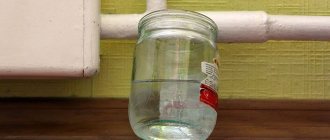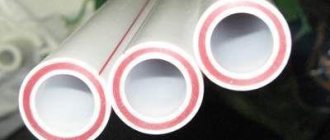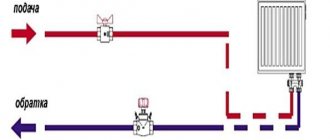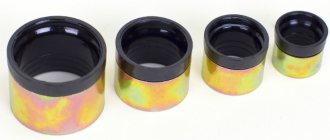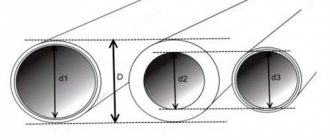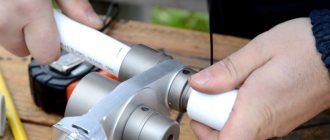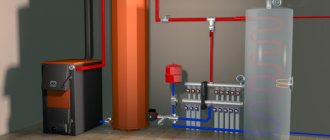During repairs, improvement of a house or cottage, the owner may have difficulty choosing suitable pipes. Emergency situations occur when an old pipeline leaks and there is a risk of flooding. To get rid of such problems, new high-quality communications should be established. In the modern market, metal-plastic pipes for heating are in great demand.
Installation of a heating system with metal-plastic pipes
Metal-plastic pipes easily change shape and are quite convenient to install.
An additional advantage is that there is no need for expensive tools; they have an attractive appearance, so painting the system is not required. You can even do without special scissors (replace with a hacksaw) and a pipe bender (a spring is enough). In order to bend metal-plastic heating pipes, various pipe benders and external or internal springs (mandrels) are used. The bending radius depends on the outer diameter of the product, but cannot exceed four diameters.
Follow installation with detachable fittings
Detachable (threaded and compression) fittings are quite expensive, but without them it is impossible to create connections between pipes and devices. If necessary, these elements can be dismantled and installed again (in compression ones, the crimp ring must be replaced).
Regardless of the fitting used, you first need to cut a piece of pipe to the desired length, calibrate the end and remove the chamfer. When cutting, maintain perpendicularity to the axis. Both the presence of a chamfer and unevenness during cutting can lead to a violation of the tightness of the connection.
If the fitting is threaded (coupling, tee, cross), then it is enough to screw the pipes to its ends. If it is compression, then it is equipped with a special nut, which should be tightened with a wrench immediately after the pipe is inserted into the fitting. Both threaded and compression ones do not require the use of special tools during installation, but they must be monitored during operation, since such connections tend to relax. They are used for open installation, as well as for connecting to manifolds, installing radiators and connecting to valves.
Sequence with press fittings
If it is necessary to monolith metal-plastic pipes for heating, installation is carried out using press fittings that cannot be disassembled and do not require maintenance during operation. In this case, you cannot do without a press tool that compresses the sleeve around the fitting.
When installing a heating system, you can use fittings made of plastic, bronze and brass.
Metal-plastic heating pipes have not only advantages, but also disadvantages:
- the “layer cake” design is weakened by repeated deformations caused by temperature fluctuations;
- the cross-section of the fitting is narrower than the cross-section of the pipes;
- high-quality fittings are very expensive;
- counterfeit materials create problems during operation of the heating system;
- metal-plastic is unstable in relation to ultraviolet rays, mechanical and thermal influences.
The cost of high-quality metal-plastic cannot be less than 90 rubles per meter. This should be taken into account when purchasing. For example, metal-plastic pipes for heating rehau with a diameter of 16 mm cost 119 rubles per meter, with a diameter of 40 mm - 959 rubles per meter.
Installation of heating and water supply systems has become significantly easier with the advent of a new building material on the market - metal-plastic pipes. They have a number of advantages: they bend easily and reliably retain their given shape, are resistant to corrosion, do not require painting, have a lower noise level of liquid flow, are light in weight, and the flow area does not narrow during the entire period of operation.
Polyethylene is inert towards aggressive environments, and metal-plastic pipes are not subject to corrosion.
Regardless of what diameters of metal-plastic pipes are used in installation, the expansion coefficient of the material is always the same.
This ensures the reliability and durability of the pipeline
It is important that these products can come into contact with any materials, including concrete. They have proven themselves well in the Russian climate and can work without insulation at a temperature of -25°C
They are sold in coils and measured in linear meters. Flexible, allowing installation without the use of special tools.
Review of manufacturers and prices
Metal-plastic products are manufactured in many countries: Russia, Germany, Italy, China, Turkey and so on. The modern market is constantly growing, so manufacturers have to withstand fierce competition. The main goal of companies is to create truly high-quality products that meet all requirements.
When choosing communications, price is of considerable importance, especially if you plan to equip long-distance highways. Metal-plastic pipes for heating can have different prices per meter, which are indicated on the website of the manufacturer or official dealer.
It must be taken into account that the final figure is formed based on the quality of the product and the popularity of the brand that produces the product. For this reason, there are products on the market at prices starting from 600 rubles per meter. Of course, this is an inflated cost, because you can buy pipes for 50 rubles.
Among the available companies, it is worth highlighting Aquapipe and LTM from Turkey and China, respectively. Despite the relatively low cost, the products are of decent quality and meet all standards.
Metal-plastic pipes for heating, price per meter in rubles:
- Valtec - from 70;
- Fado - from 102;
- Golan - from 175;
- Henco - from 35;
- Kermi - from 78;
- Polvax - from 70;
- Rehau - from 165.
Even well-known brands offer affordable prices for their products. It should be borne in mind that the price also depends on the diameter of the product.
Prices for metal-plastic pipes
metal-plastic pipes
Diameters of metal-plastic pipes
These are the most popular metal-plastic products for wiring heating and water supply systems in city apartments. Lime and rust do not accumulate in them and do not block the passage of the working environment. The fittings for them are the most inexpensive, which is the determining factor in the choice. 16 mm products are often used as outlets for faucets in the bathroom and kitchen, when installing meters, while the main pipelines can be made with larger diameter products.
20*2, where 20 is the outer diameter, 2 is the wall thickness, and the internal section is 16 mm;
A variety of fittings allow for competent and technologically correct wiring of systems.
These metal-plastic products are traditionally used in the installation of “warm floor” systems. The fittings on them are more expensive, but the throughput is higher than the previous ones. Therefore, if the water pressure is unstable, it is better to use them for installing hot and cold water supply systems than 16 mm metal-plastic pipes. Especially if you need to run a long route. Withstand pressure up to 10 bar, which corresponds to the characteristics of steel products.
20*26, where 20 is the internal section, and 26 is the external. Wall thickness - 0.3 cm;
Often used for installation of risers and underfloor heating systems. They are the preferred choice when installing engineering systems in a private home, since for autonomous heating and water supply it is necessary to provide a higher throughput due to possible surges in internal pressure.
26*32, where 26 is the inner diameter and 32 is the outer diameter. Wall thickness - 0.3 cm;
Large diameter products are the basis of any heating and water supply systems. They are used as risers and the main pipeline in low-pressure conditions, since, thanks to their high throughput, they ensure the uninterrupted supply of a large amount of liquid.
32*40, where 32 mm is the internal section, and 40 mm is the external. Wall thickness - 0.39 cm;
They are used to create networks of central and individual heating and water supply, central air conditioning, and in water treatment systems. They are used to assemble long routes for engineering systems in industrial and civil construction.
40*50, where the internal section is 40 mm and the external section is 48 mm. Wall thickness - 0.4 mm.
One of the common materials for manufacturing is metal-plastic. This is a modern material that has excellent qualities for use in heating systems.
This gives them incomparable advantages over pipes made from other materials:
- they do not require painting;
- ease of installation - no welding machine is required for operation;
- they can be walled into the wall and poured into the floor;
- they are lightweight, there is little waste during installation;
- their throughput is almost 1.5 times higher than that of metal pipes;
- stray currents will not be able to pass through them;
- have an aesthetic appearance;
- they are easy to replace, repair, or install an additional element into the heating system (for example, an additional radiator).
Metal-plastic pipes also have minor disadvantages:
- high price for pipes and fittings for them;
- they are sensitive to defrosting;
- service life is reduced by 2 times when used in systems with high operating temperatures (about 95° C);
- the presence of many threaded connections requires careful insulation, otherwise the pipes will leak.
A metal-plastic pipe is a pipe made of modern composite material. An aluminum pipe runs inside, surrounded on both sides by plastic.
Marking
There must be inscriptions on the outside of the pipes. To make the right choice, you need to understand what they mean. Not all types of pipes are suitable for a particular task. The marking is applied by the manufacturer. In metal-plastic products, the materials of the outer and inner layers may differ.
What designations are found:
- PE - R . Indicates that polyethylene was used to make the inner and outer layers.
- PP - R . Material of manufacture: polypropylene.
- PE - X . The composition contains cross-linked polyethylene. There are also other markings indicating the method of stitching the material.
- PE - RT . Made from heat-resistant polyethylene.
After these designations the diameter and thickness of the tube are indicated. Another marking that can be found is PN, which indicates the nominal pressure that the product can withstand. The unit of measurement is usually bars. Additionally, the maximum temperature and type of permissible coolant are indicated.
Application area
Due to the technical characteristics of metal-plastic, the material has found application in pipelines for cold and hot water supply, as well as sewage.
It is used for various heating systems:
- Underfloor heating device "warm floor".
- Connection to wall-mounted radiator radiators.
- Heating of soil in closed greenhouse complexes and greenhouses.
- Water heating device for swimming pools.
- Laying protective screens for power cables.
- Compressed air supply.
Metal-plastic products can be found in air conditioning systems and in transport routes for the movement of gaseous and liquid substances.
No. 1. Performance
Of course, some of the performance qualities of metal-plastic pipes may differ depending on the materials used in production and their thickness, but most products currently sold have the following characteristics:
- maximum water temperature inside the pipe +950C;
- at a temperature of about +950C, the maximum pressure that the pipe can withstand is 10 atm;
- at water temperatures up to +250C, the maximum operating pressure can reach 25 atm;
- the pipe can withstand a short-term increase in the temperature inside it up to +110...+1300C.
Installation and wiring of the system - installation
To construct a heating circuit in a private house, you need to take into account some details. There are different system wiring diagrams
It is important to choose and design the most optimal option. Media circulation can be natural or forced
In some cases, the first option is convenient, in others, the second.
Natural circulation occurs due to changes in liquid density. A hot medium is characterized by a lower density. The water going the other way is denser. Thus, the heated liquid rises along the riser and moves along horizontal lines. They are mounted at a slight angle of no more than five degrees. The slope allows the carrier to move by gravity.
A heating scheme based on natural circulation is considered the simplest. To perform its installation you do not need to have high qualifications. But it is only suitable for small buildings. The length of the highway in this case should not exceed thirty meters. The disadvantages of this scheme include low pressure inside the system and the need to use channels of large cross-section.
Forced circulation implies the presence of a special circulation pump. Its function is to ensure the movement of media along the highway. When implementing a scheme with forced fluid movement, there is no need to create an inclination of the contour. One of its disadvantages is the energy dependence of the system. If there is a power outage, the movement of media in the system will be difficult. Therefore, it is advisable that the house have its own generator.
The wiring happens:
- Single-pipe.
- Two-pipe.
The first option is implemented through sequential flow of the medium through all radiators. This scheme is economical. To implement it, a minimum number of pipes and fittings for them will be required.
To do this, you need to use the so-called “Leningrad” wiring diagram.
It involves installing bypass pipes and shut-off valves on each radiator. This principle allows for uninterrupted circulation of the carrier when any battery is cut off.
Installing a two-pipe heating circuit in a private house involves connecting reverse and forward current to each radiator. This approximately doubles the channel consumption. But the implementation of this option allows you to regulate the heat transfer in each battery. Thus, it will be possible to adjust the temperature in each individual room.
There are several types of two-pipe wiring:
- lower vertical;
- top vertical;
- horizontal.
Lower vertical wiring involves running a supply circuit along the floor of the lower floor of a building or its basement. Then, from the main line through the risers, the carrier goes up and enters the radiators. From each device there is a “return”, delivering the cooled liquid to the boiler. When implementing this scheme, you need to install an expansion tank. There is also a need to install Mayevsky taps on all heating devices located on the upper floors.
The upper vertical wiring is arranged differently. Fluid from the heating unit goes into the attic. The carrier then moves down through several risers. It goes through all the radiators and returns to the unit along the main circuit. To remove air from this system, an expansion tank is needed. This scheme is more effective than the previous one. Because there is a higher pressure inside the system.
The horizontal two-pipe type wiring diagram with forced circulation is the most popular. It comes in three varieties:
- with radial distribution (1);
- with associated movement of liquid (2);
- dead-end (3).
The radial distribution option consists of connecting each battery to a boiler. This operating principle is the most convenient. Heat is distributed evenly in all rooms.
The option with a parallel movement of liquid is quite convenient. All lines going to the radiators are of equal length. Adjustment of such a system is quite simple and convenient. To install this wiring you need to purchase a significant number of channels.
The last option is implemented by using a small number of channels. The downside is the significant length of the circuit from the distant battery, which complicates the adjustment of the functioning of the system.
Useful tips for soldering polypropylene heating pipes
Important tips and tricks to follow:
- When the pipeline passes through a wall, it is necessary to provide for the presence of steel sleeves. They will protect polypropylene from mechanical damage.
- On straight sections of pipelines longer than 5 meters, it is necessary to provide expansion joints.
- When soldering stopcocks and valves, it is necessary to think through their position in advance so that they have free and full movement. This is a very common mistake for beginners.
- Don't forget about the clip brackets that will support the welded pipes. They should be installed in advance.
- If you are not sure of the quality of the welded seam, it is better to cut it off and redo it. Carrying out work on a finished system in the event of a leak will be problematic.
- When joining heated elements, it is necessary to take into account the joining marks on the parts. After connection, their position can be adjusted by 1-2 mm.
Heating systems: their types and installation rules
Before installing a heating system in a house, you should first decide how the coolant (in most cases it is water or non-freezing antifreeze liquid) will circulate through it. Because both the choice of heating boiler and the choice of pipes directly depend on this step.
At the moment, there are the following types of boilers used for heating private houses:
- gas - one of the most popular, powered by natural gas;
- solid fuel - also very popular, can run on various types of solid fuel (coal, firewood, peat);
- liquid fuel (diesel) – less popular compared to others and run on liquid fuel (usually diesel fuel);
- electric - optimal in conditions of lack of gas, because they run on electricity;
- combined ones are universal and can operate on different types of fuel.
As a rule, the following option for dividing heating systems is generally accepted:
- with natural circulation, in which the coolant moves due to the temperature difference: hot water rises and, gradually cooling, naturally falls down;
- with forced circulation, in which the movement of the coolant occurs due to the connected circulation pump.
The first option allows the heating system to operate only using a gas boiler, without additional installations. But, at the same time, its installation will require complex calculations, calculation and compliance with the required slopes and a strictly defined distance between the pipes.
In this regard, a forced circulation heating system has a number of advantages and is considered more efficient. A pump installed separately or built into the boiler provides the necessary pressure in the system, regardless of the presence or absence of a slope or the length of communications. Even in this case, you can install heating pipes of small diameter, which provides additional opportunities for interior design.
The pressure created in a heating system with natural circulation is usually 1.5 - 2 bar, and in a system with forced circulation - 2 - 4 bar.
Its main advantages include the absence of high temperatures and pressure, as well as the possibility of using thin metal or flexible corrugated foil pipes. But despite this, this system also has disadvantages. So, due to the strong noise and overall dimensions of such pipes, installation and installation in the wall may not always be possible.
After you have been able to decide on the type of heating system to be installed and choose the most suitable option, you should familiarize yourself with some points that are important to consider when installing it.
So, the rules for installing heating systems are as follows:
It is necessary to maintain the recommended distance between communications and not install additional objects (shut-off valves, strainer) between the boiler and the safety group (pressure gauge, relief valve, automatic air vent). In a network with a forced heating system, a strainer can be installed in front of the pump. Pipes should be selected based on the type of boiler. Different types of pipes can be combined, but you must carefully study their markings and manufacturer’s recommendations. When connecting a large number of radiators, double-circuit wiring should be done and large-diameter pipes should be installed. It is important to provide for the installation and removal of combustion products to the outside if required by the boiler design.
Now we will tell you in detail about what types of heating pipes there are, what main characteristics and properties they have.
Why is polypropylene good?
Various Internet resources have published many materials praising polypropylene (PP-R) and attributing mythical properties to it. To figure out which pipes are best to use for heating installation (including with your own hands), you need to identify the real pros and cons of PPR. If you study the advice of experts and reviews of homeowners on forums, the following picture emerges:
- The price of polypropylene pipes and fittings is the lowest among other plastic pipelines used for heating.
- PPR is harder and more durable than any polymer that is now used to install heating systems in private houses.
- High-quality heating made of polypropylene looks no worse, or even better, than steel or metal-plastic pipelines.
Note. We do not take into account the inherent advantages of all plastic pipes. For example, the absence of roughness on the inner surface, low hydraulic resistance, and not susceptible to corrosion.
The low price of polypropylene parts compared to metal plastic is the most attractive factor. The secret of the low cost lies in the design of the fittings, which are ordinary plastic castings that do not have a reinforcing layer. And the cost of PPR pipes with a reinforcing aluminum insert used for heating will not make you faint.
Perforated aluminum foil, basalt and fiberglass can act as a reinforcing layer of PPR pipes
The strength of propylene also plays an important role; it is quite difficult to break it. This favors the laying of highways in an open way in any place. The aesthetics of a beautifully assembled polypropylene system is also not the last factor, although this is not easy to achieve, as will be discussed below. This is where the positive aspects of the material end. But in order to understand what is better - metal-plastic or polypropylene, we need to consider the negative ones.
Installation of heating from metal-plastic pipes
There are 3 known ways to connect metal-plastic pipes to each other:
- threaded or collet connection. It is detachable and used as a dynamic option. If necessary, you can disconnect/connect one or another branch of the network;
- compression or conditionally detachable connection. It can also be disconnected or reconnected, but this is associated with certain difficulties;
— press fitting, a fixed connection technology that does not imply the possibility of disassembling and reassembling the unit.
Installing heating using metal-plastic pipes is easy to do yourself, since it does not require special knowledge or complex equipment. The heating system is designed in accordance with the location of the rooms, the boiler, the location of the radiators and some other factors. You can choose a collector, one- or two-pipe scheme, with top or bottom hot water supply.
The most economical is the single-pipe scheme, but the temperature of the radiators will decrease as they move away from the boiler. To distribute heat evenly between the radiators, a collector circuit should be installed. But its installation will require more material. Two-pipe is a compromise solution: heat distribution is more uniform than in the case of single-pipe distribution, and fewer pipes are required than in a manifold circuit.
Installation of a heating system based on metal-plastic pipes is carried out taking into account the following rules:
— work should be carried out at an ambient temperature of at least +10 °C;
- if the pipes were stored at lower temperatures before installation, they must be allowed to warm up to the specified temperature;
— installation of pipes should be carried out only after the final finishing of the wall surface;
— pipes should be cut only with special scissors;
— do not allow pipes to break when bending;
— attach the pipes to the hay using clamps or clips.
How defects occur when welding polypropylene
According to the technology, the polypropylene pipe needs to be cut, the depth of immersion into the fitting must be marked with a pencil, degreased and soldered, heating both elements for a certain time. The duration of heating depends on the diameter of the pipeline. If you hesitate for a couple of seconds or ignore degreasing, the connection will become unreliable. This is not determined visually, the joint will undergo hydraulic tests, and a leak will appear after 2 weeks or a year.
An example of correct soldering - the plastic did not spread and did not block the cross-section of the pipeline
Overheating of polypropylene is easier to detect than underheating. A rim of molten plastic forms outside near the tee or coupling. The same defect will appear inside the joint; it will partially or completely block the passage of the coolant.
But you can see this trouble on a cut pipe, that is, cases of underheating and overheating cannot be clearly controlled after installation work is completed. And these defects arise due to inconvenient soldering conditions and the inability of the “masters” to qualitatively join polypropylene in any hard-to-reach place.
“Welded” joint – the cross section is half blocked due to overheating
When working in extreme cold or frost, the probability of underheating of the parts being connected is very high, so it is always better to install PPR at a temperature not lower than +10 °C.
Due to the impossibility of monitoring connections, experts do not recommend making polypropylene heating hidden, walling it into walls or laying it under a cement screed to install heated floors. If there is a need to lay a PPR line in the wall, then this must be done using thermal insulation.
The reason is thermal elongation of the material, which affects the method of pipeline installation. It should slide inside the fastenings, and the ends should not rest against the walls. The best polypropylene heating pipes are guaranteed to bend if they have nowhere to expand while warming up.
What is taken into account when choosing pipe diameter
Heat generator power. It is taken as a basis and determined individually for each building. What does the owner focus on when purchasing a boiler?
For the total area of all heated premises. This is exactly what the manager at the point of sale will definitely clarify if the buyer has questions about this item.
Coolant speed. If it is less than 0.25 m/sec, then there is a risk of airing the system and causing traffic jams on the highway. Exceeding the value of 1.5 is fraught with “noise” in the highway.
This is especially noticeable when the pipes are metal, and even laid in an open way. But in any case, the movement of the coolant along the route will be clearly audible.
Practice has proven that for a private building (with an autonomous heating circuit) you should focus on an indicator in the range from 0.3 to 0.7. This is the optimal value for any system.
Circuit configuration. In private houses, when installing it, as a rule (regardless of the circuit), all the “threads” are connected to the collector. Each of them is “loaded” with a certain number of radiators.
There is no point in purchasing pipes of the same diameter for all lines, given that the larger the cross-section of the workpiece, the higher the price of 1 running meter.
Pipe diameter. The outer one does not play a special role, since products made from different materials have differences in wall thickness. This parameter only indicates the ease of fastening the product. The internal diameter is about the throughput of the route. It is he who is decisive.
Pipe diameters are usually indicated in inches. For us, this is an unusual (non-metric) system, so you should know the rules for converting quantities. The ratio of inches to centimeters is ½.54 (or 25.4 mm). Pipe material – metal-plastic, steel, PP, PE.
Specifics of the structure. First of all, this relates to the effectiveness of its thermal insulation - what materials it is assembled from, what method is used, and so on.
General requirements for the operation of pipeline systems
During operation of pipe products made of metal-plastic, the following requirements must be observed:
- Heat sources with a heating temperature higher than +150 ºC should not be placed in close proximity to metal-plastic heating pipes.
- In case of fire, use sand to extinguish.
- Periodically inspect the joints of parts and, if necessary, tighten detachable connections.
- Do not use metal-plastic pipes for external communications; system wiring in unheated rooms must be protected from heat loss.
How to connect pipes
Before installing the flange, you need to check it for the presence of various sharp parts, burrs, corners - all of them can damage the plastic pipe. When purchasing, check the flange for defects; they should not have cracks or unevenness at the joints.
High-quality pipeline connection
Let's look at how to properly connect metal-plastic pipes without threads:
- Before starting work, you need to make an even cut on plastic pipes using special scissors;
- After this, a selected flange of suitable diameter is put on the cut;
- Next, a durable rubber gasket is threaded under the flange to ensure a strong and tight connection;
- A flange is also placed on the metal pipe and is bolted to the flange connection of the plastic pipe.
To prevent sewerage connected in this way from leaking, the connection points must be treated with sealants
Also pay attention to the tightening force of the flanges. They need to be tightened firmly enough with the bolts, but do not pinch the plastic so that it does not crack under pressure.
Pipe flange
Gears are very convenient for making rotary transitions in the pipeline system. They are most often used in private construction work; they are used to connect plastic pipes with common metal pipes.
To make a threaded connection, you will need a fitting.
- At the designated junction of pipes made of different materials, the coupling is removed from the metal transition. It happens to many owners that there is no coupling in these places, in which case the main pipe is simply cut;
- To carry out the work, you will need a thread cutter - this is a special device similar to a hand cutter; it will make a thread on the cut section of the pipe;
- When working on a riser, you need to make no more than 5 turns of thread, and only 3 of them are treated with sealants and sealing tapes;
- Before covering the threads with sealants, you need to clear them of chips;
- On any hand-threaded pipes, the fitting must be screwed on only by hand. If you use special clamps, you can damage the non-standard thread and you will have to cut the pipe even further, which will shorten it;
- The fitting is simply pushed onto a PVC, PP or PE pipe;
- All that remains is to carry out welding work at the places where the fitting and plastic are attached using a special inverter.
Work is carried out similarly when heating, if you need to connect plastic pipes with metal taps. You will also need to cut a thread on one end (metal) and weld an adapter on the other. In this case, you will need an American faucet.
Fitting for copper and plastic pipe
Naturally, a flange connection is much more difficult to implement than a fitting connection, but it is considered more reliable. Do not forget to seal threaded connections with special devices: self-adhesive tapes, jute, resins.
Tips on how to make connecting plastic pipes to metal ones as simple as possible:
- Work according to the project;
- Consult with specialists; your pipeline may require a special approach and selection of adapters;
- Before starting work, be sure to turn off the water in the riser;
- Periodically check connections for leaks or physical damage;
- Metal fasteners must be treated with protective mastics, which will help prevent the appearance of rust at the attachment points of flanges and fittings.
How to identify a fake
When installing pipelines, it is very important to use high-quality pipes, which will allow the system to last for decades. Counterfeits are simply not able to withstand the existing loads; after 2-3 years they can leak. In addition, in low-quality products, the aluminum layer deteriorates over time, which can also become a problem.
A few tips to help you spot a fake:
- The pipes must be accompanied by a certificate. Of course, if there are documents, this does not mean that the product is 100% high quality, but if they are not there, this is a reason to think about it. If the supplier is conscientious, he must attach to each batch a corresponding document indicating the originality of the products.
- Visual characteristics. The marking and appearance of the pipe must be the same as indicated on the manufacturer’s website. You need to be vigilant when purchasing products.
- Pipe cut quality. If the aluminum is butt welded, everything is fine, but if the seam is made “overlapping,” the product is of low quality. You also need to pay attention to the thickness of the aluminum - it should be identical throughout the entire diameter. The same applies to the outer and inner layers.
By adhering to these rules, the likelihood of buying counterfeit goods can be minimized. The key to the efficiency of a heating system is properly installed high-quality pipes.
DIY installation features
Self-installation of an individual heating system has its own characteristics and nuances. Most questions arise regarding the issues of giving the desired shape to the pipe line and the choice of connection methods.
How to bend a pipe
The most optimal way to bend a pipe is to use a special device - a pipe bender. If this is not available, an alternative method of bending is used by heating with a construction hairdryer. It should be remembered that, unlike steel, metal-plastic is a more fragile material and therefore the bending radius is equal to seven times the diameter of the pipes being connected. If the bending angle is smaller, it is best to install an elbow fitting.
Connection methods
With an open installation method, experienced plumbers recommend connecting individual sections of the thermal distribution with compression fittings. If pipes are laid in a hidden way, for example, in a floor structure, press fittings or crimp couplings are used.
Detachable connections are installed only with open heating pipelines.
Design features
The technical characteristics of metal-plastic pipes for heating are based on the use of polymer materials. For their production, cross-linked polyethylene is used. But since it does not have the required degree of rigidity, an additional layer of foil is installed to give the products the required properties.
The technology for creating metal-plastic pipes allows them to be produced with different diameters. For this, an extrusion method is used, which consists of attaching an internal and external polyethylene layer to an aluminum base. A special adhesive composition is used as a binding component.
The inner layer has high strength, heat resistance, it does not oxidize, and salts do not accumulate on its surface. Due to the fact that the central element of the design is aluminum, these pipe products are hydraulically resistant. Since the metal is protected on both sides by polymer, it is not affected by negative external influences.
If you lay a heating system from metal-plastic pipes, then with high-quality assembly it will last a long period.
Overview of fittings for metal-plastic systems
To prepare for work, it is important to cut the pipes into sections of the required length, and all cuts must be made strictly at right angles. If the pipe is deformed during the cutting process, it must be leveled with a gauge (it will also help remove the internal chamfer)
To connect metal-plastic pipes of different categories into a single structure, connecting elements are used - fittings that differ in design, size and fastening methods
To install the structure, various types of fasteners are used - fittings; we will dwell on them separately.
Option #1: collet
Push-in fittings, consisting of a body, a ferrule, and a rubber gasket, have a detachable design, so they can be used several times. The thread of the parts allows them to be combined with household appliances.
To connect the connecting elements to the pipe, you need to put a nut and a ring in series. Insert the resulting structure into the fitting and tighten the nut. To make it easier for the pipe to pass into the connecting element, it is advisable to wet it.
Option #2: compression
Parts widely used for connecting pipes, which can be called conditionally detachable
Before installation, it is important to ensure the presence of o-rings and dielectric gaskets, which should be located on the shank of the part
Compression fittings are widely used in the construction of metal-plastic structures. They allow you to easily create connections without the use of special tools
To connect, a nut and a ferrule are put on the end of the pipe (if it has the shape of a cone, then the process is carried out on the narrower side of the part). After this, the shank is inserted into the pipe (this requires some effort), and in order to seal, the part is covered with tow, flax, and sealant.
The next step is to put the union nut on the fitting body and tighten it. It is convenient to do this with the help of two keys: one of them fixes the part, the other tightens the nut.
This method is quite easy and does not require the use of special equipment, however, it is not advisable to use it for hidden wiring, since it requires checking the connection.
Option #3: push fittings
Convenient connecting elements that do not require special tools for fastening. For installation, it is enough to insert the product into the connecting part, and the end of the pipe should be visible in the inspection window.
Immediately upon completion of installation, thanks to the included water jet, the fitting wedge is pushed forward, forming a clamp that prevents leakage.
This method allows you to quickly and easily create the required structure, ensuring high-quality, durable connections. Almost the only drawback of push fittings is their high cost.
Option #4: press fittings
These elements are used to create permanent connections using press jaws or similar devices.
Press fittings create tight, long-lasting connections, but can only be used once. In addition, to work with such elements you will need press pliers.
To connect using press fittings, you need to calibrate the part by removing the fez from it, after which the sleeve is put on it and the fitting is inserted. The sleeve is grabbed by press jaws, after which the part is firmly clamped by bringing the handle together.
This element can only be used once, but the fasteners mounted with it are quite tight and reliable, making them suitable for hidden wiring.
Installation of press fittings is carried out in the following order:
Installation of pipes from different types of materials
To connect elements, one of which is made of metal and the other of metal-plastic, special fittings are designed, one end of which is equipped with a thread, and the other with a socket.
For installation, a metal pipe needs to be threaded, wrapped in tow, lubricated with soap or silicone, and then the fitting is put on by hand. After its second end is connected to the plastic element, the thread is completely tightened using a wrench.
Assortment of fittings of different shapes
For ease of installation, the connecting elements can have different shapes. The most common are:
- adapters for connecting pipes with different diameters;
- tees providing branches from the central pipe;
- corners for changing the direction of flow;
- water sockets (installation elbows);
- crosspieces that allow you to organize different flow directions for 4 pipes.
Press fittings can have a special configuration (couplings, triangles, tees).
Installation nuances
Metal-plastic has gained such wide popularity primarily due to its ease of installation. An important feature of this product is that it is distributed in coils, and not in separate pieces, like polypropylene products. This allows the pipe to be cut to the length required.
Another point is that the products are very easy to bend without the use of additional tools. Such deformation does not in any way affect the performance characteristics of the material.
Before laying communications, you need to install ball valves, filters and a device for measuring water flow into the system, which is usually done by plumbers.
Connection and connection of metal-plastic products is carried out using fittings, which are sold in all hardware stores. Thanks to their large number, it will not be a problem to choose the right element even for a complex harness.
Sequence of installation work:
- A piece of pipe of the required length is cut with special scissors.
- During cutting, the edge of the product can be damaged. This shortcoming is corrected by such a tool as a calibrator.
- For strong fixation with the fitting, it is recommended to treat the edge of the pipe with a chamfer.
- A union nut and a fitting collet are put on the product.
- The shank of the connecting element is carefully inserted into the pipe; it must fit completely.
- The union nut is tightened - first by hand, and then tightened using a tool.
- Another section of pipe is connected in the same way.
Even a beginner in the field of construction can cope with joining metal-plastic, which can easily be attributed to the advantages of the material. Study the long-burning solid fuel heating boiler using the link.
Installation process
As we said above, most negative reviews about metal-plastic pipelines are associated with errors made during installation of the system. Therefore, before starting the actual installation, you need to study the manufacturers’ recommendations and read the instructions for installing the heating circuit from the products in question.
Before installation begins, a diagram of the future highway is drawn up. The location of the threads and other necessary components is placed on the house plan. After this, they calculate the volumes of materials that will be required to solve the problem.
The step-by-step installation looks like this:
- A piece of pipe is cut off with scissors.
- The calibrator is used to align the inlet pipe for connection to the fitting.
- The press fitting is mounted and clamped using crimping pliers.
If you have purchased high-quality metal-plastic pipes, it is permissible to use a spring pipe bender. In this case, the minimum bending radius must be carefully observed. It directly depends on the cross-sectional index of the product.
Advantages over others
Metal-plastic pipes are especially durable and efficient. When wondering where to buy metal-plastic pipes for heating, you must remember that you need to pay attention to the main positive qualities of the product provided by each manufacturer:
- Metal-plastic pipes are not subject to corrosion, deposits and blockages do not form on them. The smooth inner surface is not subject to oxidative processes. The material does not change its state, and the composition of the transferred liquid does not change throughout its entire service life.
- Resistance to aggressive environments on the outer layer.
- The formation of silt and growth in the inner part of the pipe are excluded even after 10 years of operation.
- Easy to use. Installation of metal-plastic pipes is considered one of the simplest, since they are quickly attached without causing difficulties, bend easily, and are highly resistant to damage during installation. Their light weight is noted, which helps speed up the work on fixing pipes.
- Wear resistance. The inner surface is very durable and therefore does not deform even at high speeds of movement of the working medium.
- Efficiency. Polymer materials used in the production of metal-plastic pipes have a much lower thermal conductivity coefficient than metals, so heat loss is minimized.
- Small number of connections. The elasticity and flexibility of the pipes is characterized by the highest rates, therefore, to avoid corners and irregularities on the surface, the use of additional fittings will not be required, which significantly increases the reliability of the entire system.
- During the installation of metal-plastic pipes, a minimal amount of waste is generated.
- Heating pipes are sold in coils, so the consumer can measure the necessary parameters of the material in advance, and the seller will cut the footage specified by the buyer.
- A standard set of tools is required. Without additional processing or restrictions, the pipes can be placed under the screed, that is, after installation, they can be filled with concrete.
- Repairs can be carried out without the use of professional pipe bending and welding equipment, so the owner, having the necessary knowledge, will be able to carry out repair work independently.
- Low price. The purchase of equipment and labor costs for workers cost a small amount, since the cost of the raw material and the time spent on installation are small.
Basic rules for installing metal-plastic pipes
Metal-plastic pipes are highly sensitive to mechanical damage, temperature influences, and do not tolerate direct exposure to ultraviolet rays. Therefore, open laying of metal-polymer pipes is possible only in those places where the presence of these factors is excluded.
In order to easily repair concealed metal-plastic pipes with screw fittings, it is necessary to provide inspection hatches at the joints. These elements should not have sharp edges.
Metal-plastic pipes are laid through building structures using sleeves. There should be a gap of 3-5 mm between the inner surface of the sleeve and the outer side of the pipe, which is created using a soft, non-flammable material that allows longitudinal movement of the pipe.
Therefore, sharp objects should not be used when unpacking pipes. Marks can only be drawn with a marker or pencil.
For the installation of press fittings, reliable equipment is used, which eliminates the creation of poor-quality connections.
Installation of metal-plastic pipes - video materials will help you cope with this process - should be carried out using hangers and supports offered by pipe manufacturers. When using metal fasteners, the pipe is protected with gaskets made of soft materials.
To solve the question of how to repair a metal-plastic pipe, you can choose one of the options:
- to eliminate a leak, it is necessary to cut out a piece of pipe and install a new one using a connecting fitting;
- if the leakage area is small, you can install only a connecting fitting without buying a new pipe;
- The leak can be sealed by installing a flange with a gasket or sealed with epoxy glue or sealant.
Metal-plastic pipes are the most versatile among polymer pipes; they are reliable in operation, easy to install and have an aesthetically attractive appearance. It is these properties that explain the growth of their popularity.
Selection principle
The set of advantages for both types is quite large. Therefore, when choosing, you should take into account the place where the pipe will pass, so that the characteristics of the material do not affect ease of use:
Polypropylene or metal-plastic pipes
- A metal-plastic pipe “sweats” almost the same as a steel pipe. Sweating structures are not suitable for all rooms.
- Polypropylene is lighter in weight.
- The level of heat resistance of metal-plastic is much higher (up to 110 0C). Therefore, it is good for installing heating, underfloor heating, and hot water supply.
- Metal-plastic is flexible. With pipes in a polymer sheath made of polyethylene, you can install water supply without using corner fittings, simply by bending them.
- Metal-plastic and polypropylene pipes have low resistance to thermal deformation compared to metals, but this indicator is much higher for metal-plastic.
- When installing polypropylene pipes for heating and hot water, compensation loops should be provided due to changes in the size of the pipeline when heated.
For urban pipelines, the response to water hammer during system checks and pressure drops is very important
Polypropylene ones burst in one place and form a leak, while metal-plastic ones delaminate over a fairly large period, although they can withstand much greater loads, this is especially important for supplying hot water and heating. Therefore, when eliminating a leak and replacing part of the water supply system in metal-plastic, you will have to change a larger piece
Types of plastic pipes
Related video: Which pipe is better - PPR, polyethylene or metal-plastic?
Publications on the topic
How and with what to solder plastic pipes
Features of insulation of sewer pipes
Simple and affordable methods for connecting pipes without welding
Tools and materials for laying pipes
Laying metal-polymer systems requires a minimum of devices and materials, but it is better to choose high-quality devices and pipes.
Pipeline installation accessories
To create a structure made of metal-plastic, a very modest set of tools is enough: a pipe cutter, a simple pipe bender, press pliers, a sliding and spanner wrench.
To install a metal-plastic system with your own hands, you need a minimum of tools, which can be purchased in a set or separately from a construction supermarket.
To separate measured sections of pipe from the coil, it is advisable to stock up on a pipe cutter designed for cutting metal-plastic pipes. Since metal-plastic is a fairly malleable material, it can be cut with a hacksaw or even a sharp knife.
However, ideal perpendicularity of the lines, without which it is difficult to obtain a tight connection, can only be achieved by using a special cutter.
Different types of wrenches are important for installing and assembling threaded connections on pipeline fittings. If absolutely necessary, you can get by with one spanner, but for comfortable work it is better to use two spanners and one adjustable wrench.
A gauge is an important tool for creating an accurate and tight connection between a pipe and a fitting: it allows you to center the cut plane and chamfer the inside of the product.
The pipe bender allows you to change the configuration of the element, so you can save on corner fittings
It is especially important to have this tool if the design involves a large number of angular mates
Before starting work, we advise you to familiarize yourself with the rules and specifics of crimping metal-plastic pipes.
What materials will be needed?
To lay the pipeline, it is important to stock up on the following components:
- pipes (coils, measured sections);
- various fitting options (bends, tees, corners), with the help of which individual sections of pipes are transformed into a single system;
- fastening elements - dismountable clamps and clips, with the help of which metal-plastic structures are fixed to supporting surfaces, most often on the wall.
It is important to select all the necessary materials and tools in advance so that you can carry out all the work smoothly. This article will introduce you to the range of metal-plastic products for pipeline assembly.
This article will introduce you to the range of metal-plastic products for pipeline assembly.
Date: September 25, 2022
Assembly
In general, there are few subtleties in installing heating with metal-plastic:
- It is best to wrap threaded connections with a steel pipe using plumbing linen with quick-drying paint
(for example, NC). In this case, the flax does not rot or fade; - You can cut metal-polymer pipes with a grinder with any cutting wheel or a hacksaw for metal. I already wrote above about the need for calibration, deburring and chamfering;
- A jumper
is required in front of ball valves or throttles that cut off the radiator . Otherwise, you will begin to regulate the permeability of the entire riser. In an apartment building, neighbors will not hesitate to pay you a visit and protest this technical solution in unparliamentary terms;
- When tightening the nut on the compression fitting, hold its body with a second wrench to prevent disruption of previously installed connections;
- Turns are made using corners, not bending the pipe. With a large bend radius, the liner will look sloppy; with a small radius, you are likely to break the aluminum core of the pipe;
- To connect the liner to the radiator, use American ones
. They will allow you to quickly disconnect the heating device if necessary.
In the photo there is an American woman on the radiator connection.
Selection of fittings
To install heating from metal-plastic pipes with your own hands, two types of fittings are used:
- clamping
Clamp fitting
The connection is made using an O-ring and collet. Therefore, it is also called collet pipe connection. A collet is a ring that has a connector. When you start tightening the nut, it puts pressure on the ring, which, in turn, contracts, wrapping around the outline. To ensure a tight connection, there are two rubber seals on the shank of the fitting, which is inserted inside the pipe. It is important that they remain there after assembling the circuit, since installation errors lead to their rupture. It is possible to dismantle the fitting in order to repair the heating system;
- sliding
Press fitting
A permanent type of connection that cannot be dismantled. Here the fitting body is also secured in the pipe with a ring. Only it differs in design from the collet. The press ring has no breaks and its width matches the length of the fitting shank. The ring is clamped using mechanical or electrical presses.
Heating scheme
In this case, we recommend using two-pipe wiring, when one pipe is the supply and the second is the return. If the house has two floors, it is necessary to make an independent bottling for each - place two pipes on the first floor and two pipes on the second. Place the pipes into the installed hydraulic unit with the boiler.
Advice: if you connect the supply and return, and then bring them to the boiler through a common pump, the system will work, but its power may not be enough due to the large number of consumers.
When drawing up a pipe routing diagram, you must proceed from the fact that the heat generator and hydraulic unit will be located as low as possible against all radiators. Please note that humidity is contraindicated for an electric boiler, so choose the driest place for it.
Two-pipe heating distribution
To ensure uniform coolant flow and heat distribution across the radiators, we recommend reducing the diameter of the pipeline after each radiator, except for the end radiators. Installation of a heating system using this method has become most widespread along with radial wiring. The latter, although it has some advantages, is much more expensive due to the large number of pipes used.
Comparison with analogues
If we consider heavy all-metal communications, then metal-plastic pipes for heating systems are in a more advantageous position, firstly, due to their low weight, and secondly, due to their resistance to aggressive environments, in particular, to the formation of corrosion. Additionally, these factors are the reason why metal-plastic pipes of different sizes for heating systems are much easier to install, since it becomes possible to work without anyone’s help.
Watch the video and compare with analogues:
https://youtube.com/watch?v=7j6sJra-Dqc
Even if someone points out the need to clean such products as a disadvantage, the counterargument on this issue is the short duration and simplicity of this operation. To connect individual sections of the pipeline, it is enough to have at your disposal a special soldering iron for this material.
Features of pipe structure. Specifications
Water supply and heating metal-plastic pipes consist of 5 layers:
- internal polyethylene gives the product smoothness and also prevents the growth of bacteria and the accumulation of harmful substances;
- 2 adhesive layers connect aluminum and polymer;
- aluminum foil, which gives the pipeline hydraulic resistance and oxygen impermeability;
- The outer layer of polyethylene gives the pipeline high temperature resistance and also protects against mechanical stress.
Metal-plastic pipes do not contain substances harmful to the human body, therefore such pipelines are used in drinking water supply systems.
In order to install heating channels according to all the rules, you need to comply with technical standards and take into account the features of metal-plastic pipes. Main parameters:
- the pipeline can function effectively at a coolant temperature of no more than +95° C;
- the maximum pressure value that should be created at a temperature from 0 to 25 ° C is 25 Bar, at 95 ° C - 10 Bar.
Compliance with these technical parameters guarantees a pipe service life of 40–50 years.
Marking
Marking
- pipeline diameter;
- polymer type: polypropylene (PP-R); polyethylene (PE-R); heat-resistant polyethylene (PE-RT); cross-linked polyethylene of increased strength (PE-X);
- nominal pressure (PN);
- type of pressure coupling (a, b, c, d);
- batch number;
- production date, etc.
Before purchasing metal-plastic pipes, each buyer has the right to request a quality certificate for the goods being sold.
